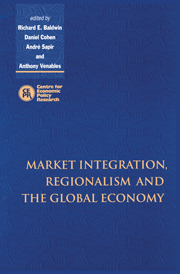Book contents
- Frontmatter
- Contents
- List of figures
- List of tables
- Preface
- Acknowledgements
- List of conference participants
- 1 Introduction
- PART ONE REGIONALISM AND THE GLOBAL ECONOMY
- PART TWO MARKET INTEGRATION AND REGIONALISM
- 7 Operationalising the theory of optimum currency areas
- Discussion
- 8 European migrants: an endangered species?
- Discussion
- 9 Geography and specialisation: industrial belts on a circular plain
- Discussion
- 10 Convergence … an overview
- Discussion
- 11 Convergence as distribution dynamics (with or without growth)
- Discussion
- Index
7 - Operationalising the theory of optimum currency areas
Published online by Cambridge University Press: 24 February 2010
- Frontmatter
- Contents
- List of figures
- List of tables
- Preface
- Acknowledgements
- List of conference participants
- 1 Introduction
- PART ONE REGIONALISM AND THE GLOBAL ECONOMY
- PART TWO MARKET INTEGRATION AND REGIONALISM
- 7 Operationalising the theory of optimum currency areas
- Discussion
- 8 European migrants: an endangered species?
- Discussion
- 9 Geography and specialisation: industrial belts on a circular plain
- Discussion
- 10 Convergence … an overview
- Discussion
- 11 Convergence as distribution dynamics (with or without growth)
- Discussion
- Index
Summary
Introduction
In the literature on optimum currency areas (OCAs), theory has always run ahead of empirics. The classic contributions of Mundell (1961), McKinnon (1964) and Kenen (1969) were essentially theoretical. Beyond some casual observations – Mundell's to the effect that Western Canada and the Western United States were subject to many of the same disturbances, McKinnon's that Canada was more open and tradedependent than its neighbour to the south, Kenen's that the US economy was more sectorally diversified and less susceptible to idiosyncratic national shocks – little was done to fill the analytical framework with empirical content. This is not a criticism of the founding fathers of the theory of OCAs; the real puzzle is that so little systematic empirical work seeking to operationalise this literature has been undertaken over the course of the succeeding quarter-century.
In this respect, the debate over European monetary unification provoked by the Delors Report and the Maastricht Treaty has served as a healthy corrective. Recent years have seen a wave of empirical studies attempting to operationalise the theory of OCAs as a way of marshalling evidence on EMU's costs and benefits. It is that empirical literature that we seek to survey in this chapter. The fact that recent empirical work is itself a product of the debate over EMU necessarily lends our discussion a European cast.
There exist a number of recent surveys of the theory of OCAs, including several which take into their compass both theoretical and empirical studies. Our purpose here is different: we focus on empirical work, examining the success with which theory has been operationalised.
- Type
- Chapter
- Information
- Market Integration, Regionalism and the Global Economy , pp. 187 - 216Publisher: Cambridge University PressPrint publication year: 1999
- 6
- Cited by



